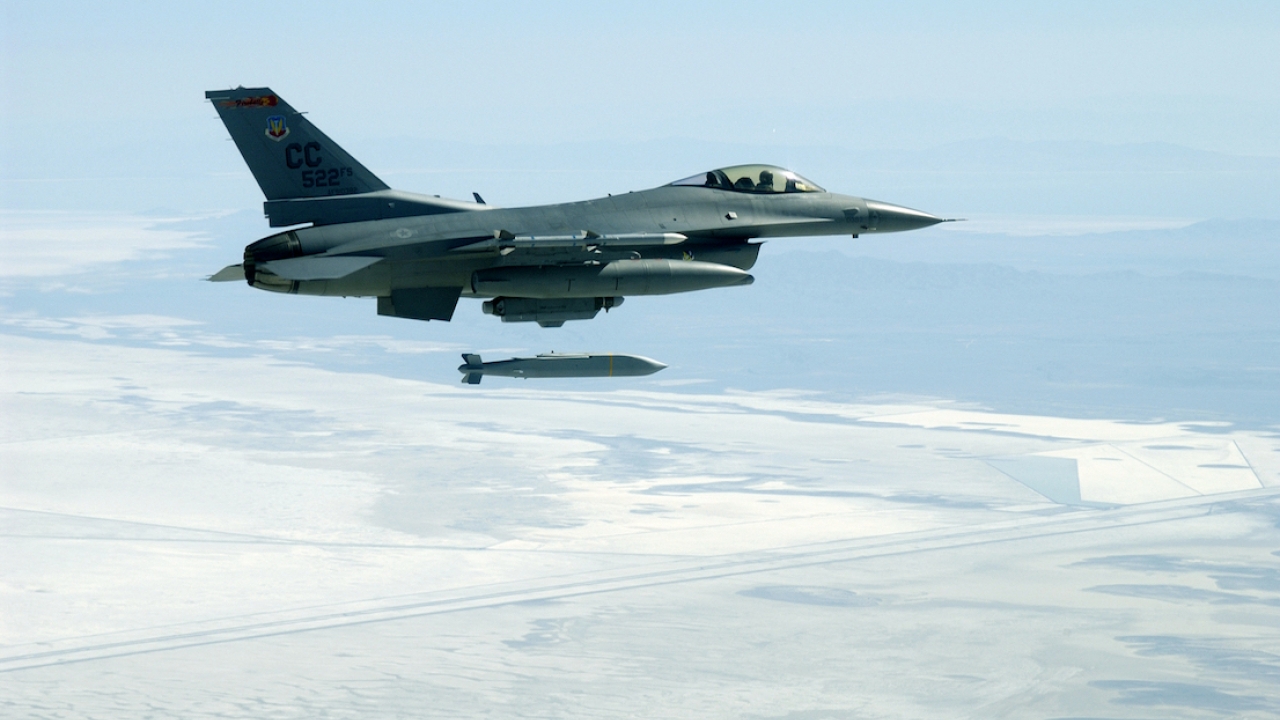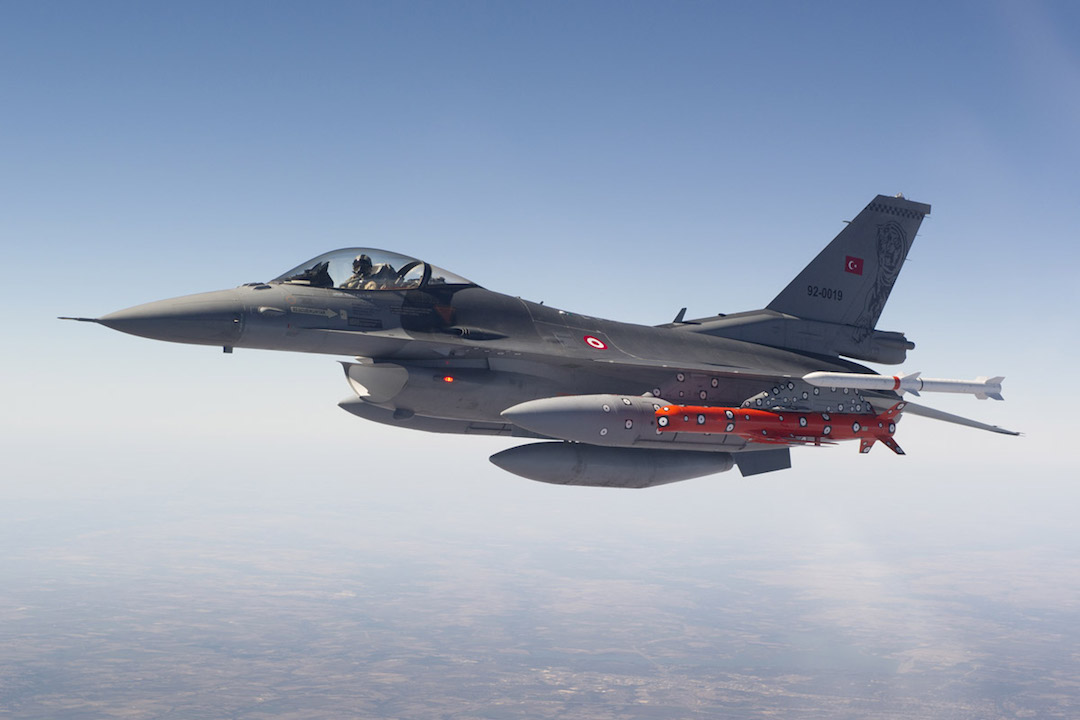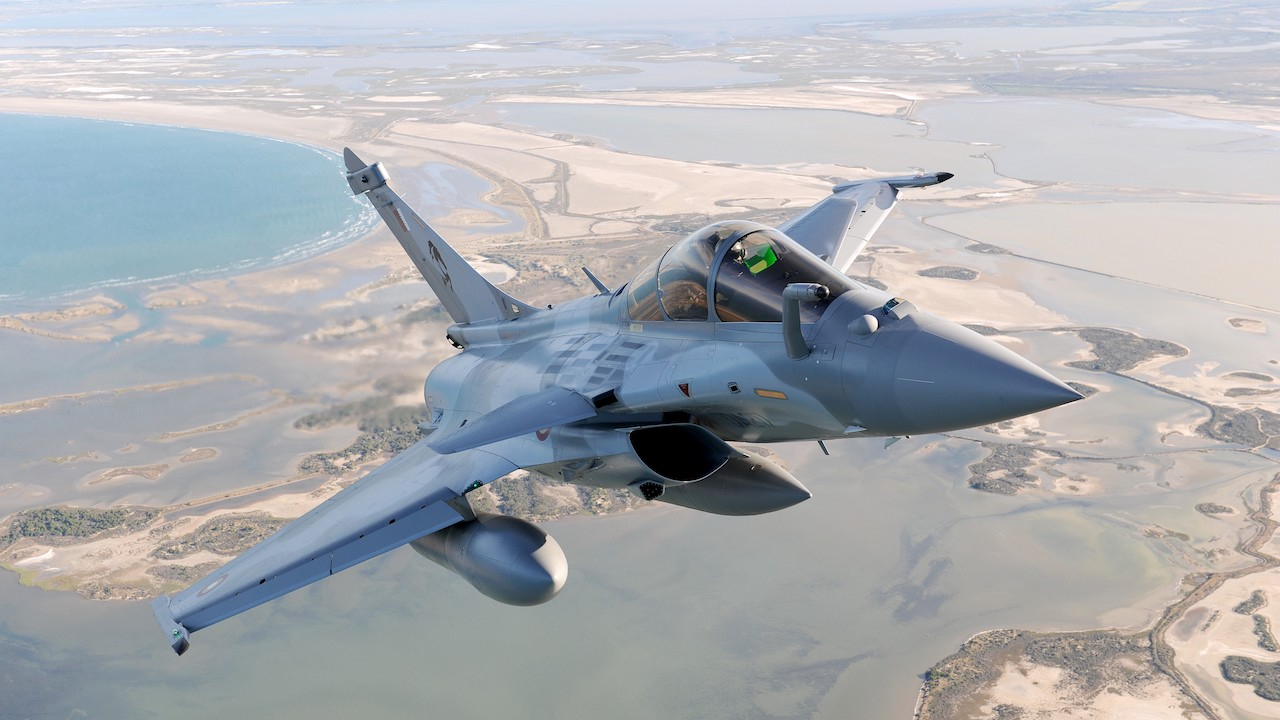Hitting on missiles
Middle Eastern air forces are increasingly fielding a new class of very-long-range stand-off missile, despite the strictures of the multilateral Missile Technology Control Regime (MTCR) and the fact that the US is determined to limit the range and payload of any such weapons systems supplied to its regional allies.

An F-16 drops an AGM-154 JSOW. Picture: US Air Force
Pressure on Arab air forces to acquire long-range stand-off attack capabilities has grown inexorably as they have increasingly embraced a wider spectrum of roles and capabilities.
Their ambition to become ‘full-spectrum air forces’ has been encouraged and furthered by the US.
America’s increasing pivot to Asia has led to a gradual drawdown of US forces deploying to the region, and to an expectation that local nations would shoulder a growing share of the burden of their own defence.
With increasingly lethal defences, and a more heavily contested air environment, any air force that might need to take part in a peer-on-peer (or near-peer) campaign will inevitably need a suite of new capabilities.
As a bare minimum, this will include stand-off precision-guided munitions (PGMs). These must be capable of delivering a meaningful payload over sufficient range to avoid the launch aircraft having to penetrate too many layers of an enemy’s defences, and must have sufficient accuracy to be able to knock out targets, while minimising collateral damage.
This need for stand-off weapons was required in order to avoid unnecessary losses to enemy air defences, but has been made more difficult as a result of the Missile Technology Control Regime (MTCR) agreement.
MTCR is not a formal treaty, but is rather an informal political understanding – originally among the G7 group of nations, but now involving some 35 member states.
The agreement’s purpose is to limit the proliferation of weapons of mass destruction (WMD) and it does this by controlling the export of potential delivery systems – other than manned aircraft.
MTCR places particular emphasis on those missiles and unmanned aerial vehicles that are capable of delivering a payload of at least 500kg (1,100lb) to a range of at least 300km (190 miles), and it effectively prohibits the export of weapons systems in this class by (or to) MTCR signatories.
For many years, the US deliberately kept certain classes of weapons from its Middle Eastern allies. This was, in part, in an effort to avoid proliferation, in the same way that AIM-120 AMRAAM air-to-air missile sales to the region were initially denied.
But it was also to avoid giving Arab air forces weapons that could erode the Congressionally mandated Israeli ‘qualitative military edge’ – or that could even provide a possible tool for striking Israel.
Such a fear was unrealistic – for the past 30 years, Israel has never been attacked by an Arab state allied to the US – or not with anything more potent than rhetoric or robust condemnation for its treatment of the Palestinians!
Keeping local allied air forces weak in this way made some sense, as long as their purpose was to adding local ‘flavour’ and colour (and therefore legitimacy) to a US-led coalition.
It made sense while the primary role of the local air forces was air defence, freeing up US platforms to go and strike the enemy.
It continued to make sense even when those local air forces started to make a more meaningful offensive contribution, as that contribution was, initially at least, one that saw them adding mass to a force, bulking up the numbers of bomb-carrying F-16s, and leaving ‘higher-end’ roles to US, British and French units.
Some stand-off capabilities were deemed relatively ‘harmless’ – and there was never any real attempt to limit the export of battlefield weapons like the AGM-65 Maverick, nor of glide bombs like the GBU-31 joint direct attack munition (JDAM).
But, as the operational environment became more contested, and the use for simple ‘bomb-droppers’ declined, the need to provide more powerful armament became ever more pressing.
The US has allowed a ‘top tier’ of MENA allies – usually Saudi Arabia, the UAE, sometimes Morocco, and, until recently, Turkey – to take delivery of more advanced weapons systems. These include the 60-mile range AGM-88 high-speed anti-radiation missile (HARM) and the AGM-154 joint stand-off weapon (JSOW), a glide bomb with a range of 22km (12nm) following a low-altitude release, and 130km (70nm) when dropped from high altitude.
The JSOW has been exported to Morocco, Saudi Arabia, Turkey and the UAE, while HARM was sold to these four nations, and also to Egypt.

More controversial from a US point of view is the AGM-84H/K stand-off land attack missile - expanded response (SLAM-ER), a derivative of the Harpoon anti-ship missile, which carries a 360kg (800lb) warhead, out to a range of 270 kilometres (170 miles).
The SLAM-ER is an extremely formidable weapon, packing a lethal punch and with great accuracy. In 2009, it achieved the best circular error probable (CEP) of any missile used by the US Navy, thanks to its global positioning system (GPS) and infrared imaging.
The missile incorporates a General Electric automatic target recognition unit (ATRU) that processes pre-launch and post-launch targeting data, allowing the weapon to use high-speed video comparison, and enabling it to be used in a true ‘fire-and-forget’ role, though the missile also includes a ‘man-in-the-loop’ mode, allowing the pilot or weapons system officer to designate the precise point of impact, even if the target has no distinguishing infrared signature.
The AGM-84H SLAM-ER can strike both moving and stationary targets and carries a 360kg (800lb) warhead, to an MTCR-bothering range of 270km (170 miles). In the MENA region, it has been exported to Saudi Arabia, Turkey and the United Arab Emirates.
Other nations were quicker off the mark, and the Anglo-French SCALP-EG and Storm Shadow have been exported to Rafale, Mirage 2000, Tornado and Typhoon operators in the region.
SCALP EG is a low-observable air-launched cruise missile, developed by Matra and British Aerospace from 1994, and now manufactured and marketed by MBDA. Storm Shadow is the British name for the weapon. The weapons are virtually identical in all ways, excepting software and aircraft interface components. Some sources credit the basic Storm Shadow with a range of more than 300nm (560km; 350 miles) when following a lo-lo profile.
In 1996, a modified variant of the SCALP EG/Storm Shadow called the Black Shaheen was developed for the UAE, which ordered 600 missiles in 1997.
Modifications to the Black Shaheen missile included a decreased range (of 290km) and a certified sub-500kg payload to meet MTCR restrictions.
Despite this, Black Shaheen provoked a major controversy, with France and the UK claiming that the sale was in compliance with the MTCR, as the missile’s range was less than 300km – when calculated at sea level. The US, however, argued that the sale was a violation of MTCR, calculating that the missile’s range at altitude was more than 400km. MTCR guidelines were updated in 2002 to standardize how the range of cruise missiles was calculated.
The UAE Black Shaheen missiles were delivered in 2003 and were operational by 2007. Since then, Storm Shadow has been delivered to the Royal Saudi Air Force (possibly in a reduced range form), while, by February this year, Egypt had examples of the SCALP-EG for its Rafale fighters.
More recently, Storm Shadow and SCALP have been sold to Qatar, to equip the Rafales and Typhoons now being acquired.
Some nations, though, have opted to develop their own indigenous weapons. In Turkey, the SOM cruise missile has been developed by TÜBİTAK SAGE with ROKETSAN being given the role of manufacturing the missile and marketing it for export.
The SOM-B1 weighs in at 620kg (1,367lb) and has a range of more than 250km (130nm), while the latest SOM-J, which was designed specifically for internal carriage by the F-35 Lightning II, has folding control surfaces and a rocket booster, giving a modest increase in range.
Stay up to date
Subscribe to the free Times Aerospace newsletter and receive the latest content every week. We'll never share your email address.


